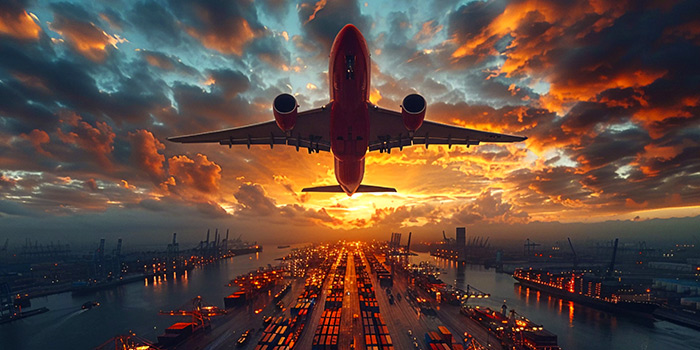Airline Cargo in 2024: Trends, Challenges, and What Comes Next
31 Dec 2024
Highlights:
2024 has ended and here is 2025, the airline cargo industry finds itself in a critical period of transformation, influenced by dynamic market demands, rapid technological innovation, and a complex global economic landscape. Let's examine the current state of the air cargo sector and identify the opportunities and challenges that will shape its path forward.

The air cargo market has made a robust recovery since the turbulence caused by the COVID-19 pandemic. According to the International Air Transport Association (IATA), the global air cargo industry generated an impressive $149 billion in revenue in 2023, reflecting a steady bounce-back from previous lows, and the growth is set to continue: global air cargo revenue is expected to increase by approximately 4% year-over-year in 2024.
How Tech and Trends Are Transforming Airline Cargo
The airline cargo sector is seizing new growth opportunities driven by e-commerce, technological advances, sustainability initiatives, and increased demand for specialized services.
The rapid surge in e-commerce continues to be a major driver, with global air cargo revenue projected to grow by 4% year-over-year in 2024, and e-commerce alone expected to make up nearly 30% of total air cargo revenue. To keep up with consumer expectations for faster delivery, airlines are enhancing their logistics infrastructure, refining cargo solutions, and offering tailored services for online retailers.
Technology also plays a crucial role, with innovations like artificial intelligence and machine learning revolutionizing operations. Airlines are utilizing these tools for route optimization, predictive maintenance, and advanced cargo tracking, which collectively streamline workflows and reduce costs. These enhancements provide more reliable and secure shipments, boosting both customer satisfaction and operational efficiency.
Environmental sustainability is an increasingly urgent priority for the industry. Airlines are turning to eco-friendly practices such as adopting fuel-efficient aircraft and sustainable aviation fuels (SAFs). Many airlines are aiming for carbon-neutral operations, and in 2024, a large portion is expected to achieve sustainability certifications, appealing to consumers and partners focused on greener practices.
Finally, the growing pharmaceutical and biotech sectors are fueling demand for temperature-controlled cargo solutions. With the market for temperature-sensitive shipments projected to reach $20 billion by year’s end, airlines are expanding their expertise in specialized logistics to capture this lucrative market. Through these diverse initiatives, the airline cargo industry is well-positioned for dynamic growth in the years ahead.
Roadblocks Ahead: Key Challenges for Growth
Despite robust growth, the airline cargo industry faces pressing challenges that threaten its momentum. Economic uncertainty looms large, with inflation, geopolitical tensions, and rising costs for fuel and labor tightening airline margins. These pressures make demand less predictable, as heightened costs may lead businesses to explore alternatives during economic downturns.
Meanwhile, capacity constraints pose another hurdle. As passenger travel rebounds, airlines struggle with limited cargo space on passenger flights, creating a delicate balance between passenger and cargo operations. These constraints can drive up shipping costs and introduce delays, particularly impacting e-commerce and pharmaceutical sectors that rely on timely deliveries.
Regulatory complexities add to the industry’s operational strain. The global nature of airline cargo requires compliance with a range of security protocols and customs regulations, which differ widely by region. Managing these requirements demands considerable resources, posing a unique challenge for smaller operators striving to stay competitive in the international arena.
Adding to these issues is a shortage of skilled labor. The demand for air cargo services has outpaced the availability of trained logistics specialists and cargo handlers, which could limit the sector’s ability to expand. With labor shortages putting a strain on operations, airlines are under pressure to attract and retain qualified personnel to meet industry demands and ensure seamless service.
Looking Ahead: What’s Next?
Looking ahead, the airline cargo industry’s journey will be marked by both significant opportunities and complex challenges. E-commerce is projected to make up around 30% of the overall air cargo market, while the demand for temperature-sensitive cargo is expected to grow by 12%. Additionally, over 50% of major airlines are set to implement carbon-neutral initiatives, reflecting a broader industry shift toward sustainable operations.
To leverage growth potential, airlines will need to continue investing in technology, improve operational efficiency, and foster collaboration with stakeholders, including logistics providers and regulatory bodies. Addressing capacity constraints, navigating workforce challenges, and committing to sustainability will be essential as airlines strive to meet evolving market expectations.
In 2024, adaptability will be key. Airlines that embrace innovation and remain agile in the face of economic and operational uncertainties are better positioned to thrive in this competitive and fast-changing environment. While promising opportunities lie ahead, tackling the challenges that accompany them will be vital to maintaining momentum and securing a sustainable future for the sector.
AviaPro Newsroom
+1 416-544-9969
info@aviaproconsulting.com

Editorial Contacts